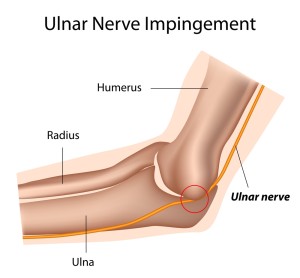Introduction
Cubital tunnel syndrome is less common than CTS. It is not uncommon among baseball pitchers as the twisting arm motion puts an extra pressure on the nerve at the elbow level. Alternative names for this syndrome are ulnar nerve entrapment or ulnar nerve neuropathy.
It originates from ulnar nerve compression mostly in an area inside the elbow (medically termed the “medial epicondyle”) where the “funny bone” of the elbow is located.
Here the ulnar nerve comes to the surface right underneath the skin. This is important for two main reasons: first the nerve is vulnerable to direct trauma in this location and the overlying scar tissue can entrap the nerve between it and the bone underneath. Secondly, there are a number of people who are born with a dislocating ulnar nerve, where the nerve dislocates every time when the elbow is flexed and eventually the nerve would be damaged, if it would not be surgically relocated.
Here is a link to a site that depicts the the location of the ulnar nerve at the elbow.
Symptoms
Weakness of the pinch grip between thumb and index finger is one of the signs along with loss of sensation in the distribution of the ulnar nerve (including the little and ring fingers). Here is a link of the numbness and pain in the distribution pattern of the ulnar nerve. If surgery is not done in time, there is a danger that a claw hand would develop with permanent contractures of muscles and tendons in the hand. This often leads to a chronic regional pain syndrome with crippling pain. Like with other diseases the key is to face the problem, see the treating physician and get an appropriate referral to a specialist who will do an electromyography to demonstrate the ulnar nerve entrapment.
Treatment
For mild to moderate cases the patient is told to avoid the precipitating motions that may aggravate the condition. Padding and preventing to injure the ulnar nerve at the inside of the elbow at the “funny bone” location (medial epicondyle) is also recommended. Occasionally, vitamin B6 supplementation may take down some minor swelling, which would improve symptoms. However, if EMG studies show that there is compression with slowing of the electrical impulses in the elbow area, surgical translocation may be required. Unfortunately, if the ulnar nerve was damaged before, this may not always solve the problem. In more rare cases another tunnel (tunnel of Guyon) at the base of the ulnar side of the wrist can entrap the ulnar nerve there and EMG studies would confirm this before the surgeon would do a surgical release in that area.
References
1. Goldman: Cecil Textbook of Medicine, 21st ed.,2000, W. B. Saunders Company
2. B. Sears: “The top 100 zone foods”. Regan Books, Harper Collins, 2001.
3. The Merck Manual, 7th edition, by M. H. Beers et al., Whitehouse Station, N.J., 1999. Chapter 176.
4. Noble: Textbook of Primary Care Medicine, 3rd ed.,2001, Mosby, Inc.
5. Goroll: Primary Care Medicine, 4th ed.,2000, Lippincott Williams & Wilkins
6.Rosen: Emergency Medicine: Concepts and Clinical Practice, 4th ed., 1998, Mosby-Year Book, Inc.
7. Ruddy: Kelley’s Textbook of Rheumatology, 6th ed.,2001, W. B. Saunders Company
8. Ferri: Ferri’s Clinical Advisor: Instant Diagnosis and Treatment, 2004 ed., Copyright © 2004 Mosby, Inc.
9. Rakel: Conn’s Current Therapy 2004, 56th ed., Copyright © 2004 Elsevier
10. Suzanne Somers: “Breakthrough” Eight Steps to Wellness– Life-altering Secrets from Today’s Cutting-edge Doctors”, Crown Publishers, 2008








